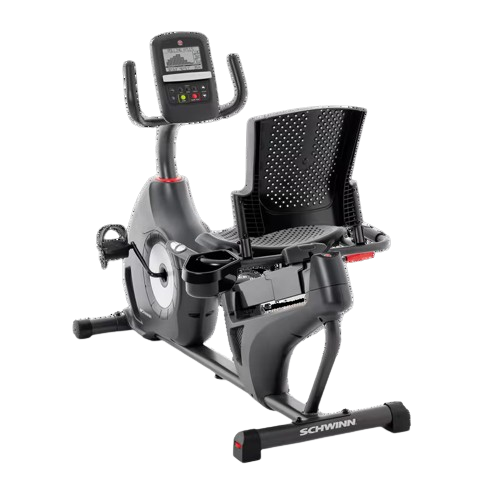Upright vs Recumbent Exercise Bike: What’s Best for You?
The rapid rise of exercise bikes has piqued the public’s interest in learning the key differences between an upright vs recumbent exercise bike. Despite the growing popularity of stationary bikes, choosing the right one for your requirements, goals, and budget can take time and effort.
Recumbent and upright bikes are two staples of every home gym right now. These two workout machines can seem similar at first. However, there could be significant variations in muscle function and comfort level.
The difference between a reclining exercise bike vs upright is quite simple to understand. Balance and physical effort are required to ride an upright bike. Those who are more into an intense workout should use an upright bike. On the other hand, the recumbent bike’s sitting posture is just like a chair. It makes getting on and off much simpler. These bikes are suitable for the elderly and individuals with mobility issues.
In this article, we will have a deeper look at reclining exercise bike vs upright so that you can choose the best one for your needs.

What Is a Recumbent Bike?
Recumbent bicycles have a chair-like seat with a broad base and back for comfort and support. As you settle into a comfortable driving position, you will notice that the handles are right close to the seat, and the pedals are upfront.
You may lay back and enjoy the ride on this unique bike. You can even watch TV or read a book while working out. It will keep you on the bike longer.
Remember that you need to work out for a considerable amount of time to reap the benefits of your efforts. Never let up on the intensity of your workouts if you want to see results from your fitness routine.
Recumbent bikes have clear panel displays. The ultra-functional LCD computer screen functions as an odometer. It has a clear panel display with extra-large numbers for easy viewing, showing time, speed, distance, and burned calories.
Recumbent bikes are the most comfortable workout bikes due to their relaxed position. These bikes are great for beginners, but even people who work out regularly will benefit from using them.
Most recumbent bikes’ safe user weight limit is 300 lbs (136 kg.). Some have a weight limit of 325 or even 350 lbs. There are a few types with weight limits less than 300 lbs, some as low as 220 lbs. These types are often relatively affordable.
You may increase the difficulty of a recumbent bike by adding more resistance, pedaling faster, or riding in reverse. Adapting the program to your current fitness level and desired outcomes is quite simple.
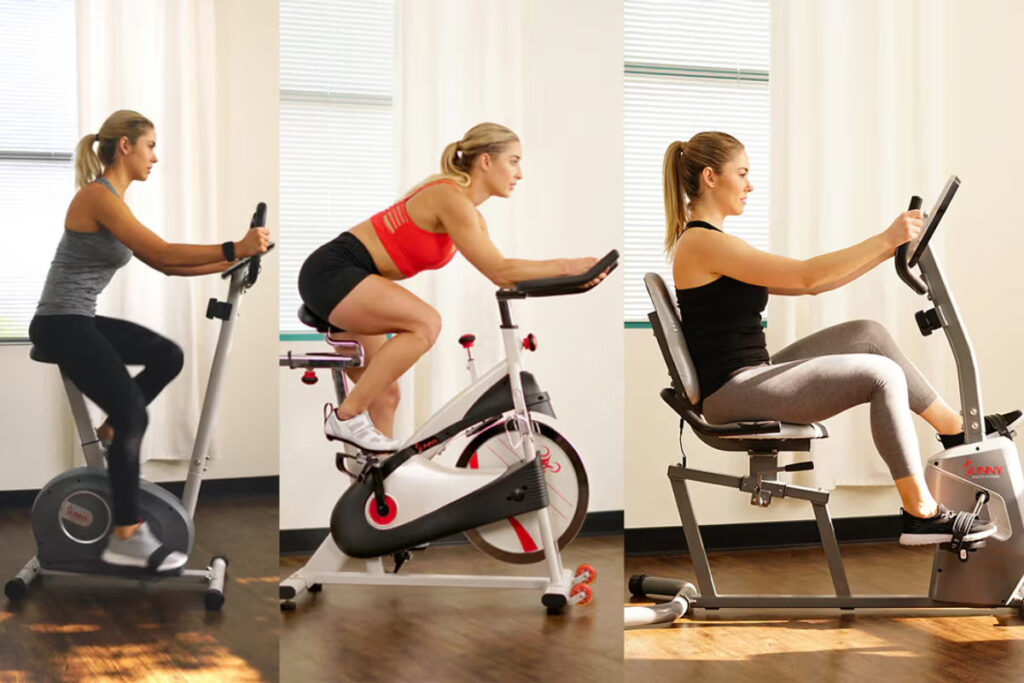
What Is an Upright Bike?
Unlike other stationary bikes, upright bikes have handlebars higher than the saddle. The higher upper body posture makes your workout session easier than stationary bike spin classes.
The design of upright bikes is based on the famous beach cruiser. Other spin bikes have wider seats for comfort and support, but the seat of an upright bike is triangular and small.
In upright bikes, the flywheel and drive train are commonly enclosed, hiding their circular shape. The grips are typically vertical in design, and the pedals are located below the seat.
For some time now, upright exercise bikes have been popular, and you have even more reasons to favor them. Why is that? For the simple reason that the newer models have more functions that help you get better exercise.
To optimize the benefits and safety of the workout, you have to make sure that the bike is set up correctly according to your physique.
Setting up a bike for your workout won’t take much time or effort. Most upright bikes include an easy-to-use screen with programming for tracking and planning workouts.
Riding an upright exercise bike does not require any particular expertise as well. It’s true because it offers a basic and low-impact form of exercise.
Upright bikes are more convenient in terms of storage and management. If you don’t have a lot of space in your house, it is a far better option than a recumbent cycle.
Recumbent vs Upright Exercise Bike
The reclining exercise bike vs upright debate continues. How much you value convenience over exercise depends on your fitness, goals, and comfort level. Let’s explore the further details below.
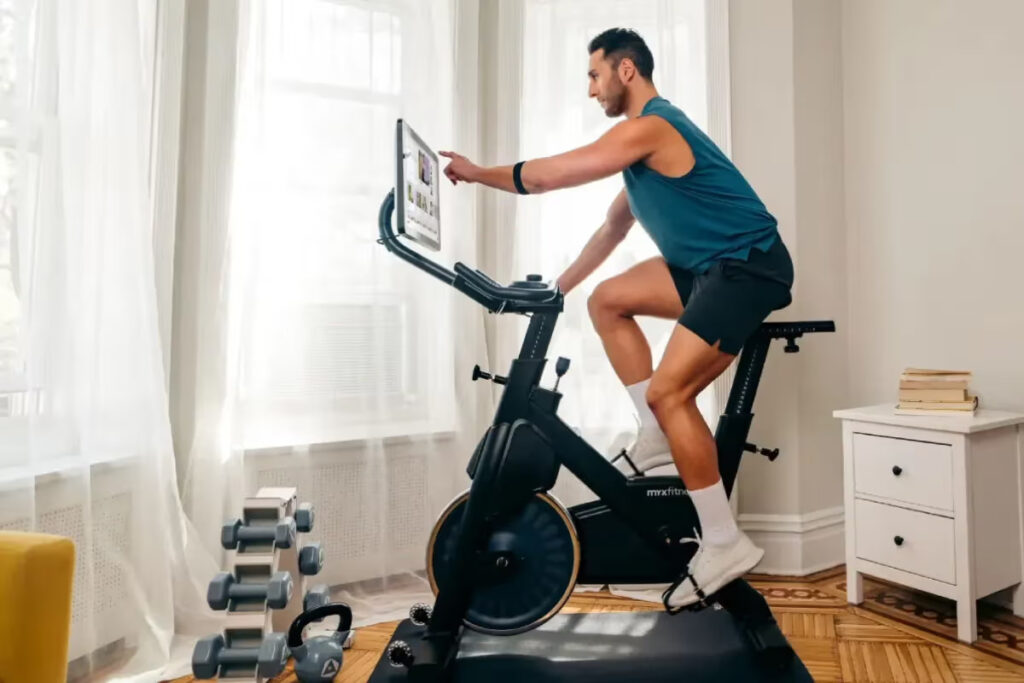
1. Burn Calories
• Recumbent Bike
Recumbent bikes may burn fewer calories than traditional exercise bikes due to their design. But how many calories you burn depends on how hard you work and for how long. It’s also possible that the recumbent bike is just as efficient as a regular exercise bike.
Due to their comforting features, recumbent bikes can make it easier for users to exercise for longer. Moreover, you can pedal faster and burn more calories in them. For customers with a weight reduction goal, this is an excellent choice.
The numbers in this table are based on a hypothetical riding speed of 12–13.9 mph.
| Weight | Duration | Burned Calories |
|---|---|---|
| 120 lb person | 30 minutes | 168 |
| 120 lb person | 60 minutes | 336 |
| 120 lb person | 120 minutes | 672 |
| 200 lb person | 30 minutes | 336 |
| 200 lb person | 60 minutes | 672 |
| 200 lb person | 120 minutes | 1.344 |
| 250 lb person | 30 minutes | 441 |
| 250 lb person | 60 minutes | 882 |
| 250 lb person | 120 minutes | 1.764 |
• Upright Bike
Most people believe that riders would burn more calories on upright bikes since they use more muscle groups.
Remember that there are other considerations. You may notice that your workouts on these bikes are shorter because of the discomfort they cause. Your motivation to go out and burn calories may drop as a result. However, it’s a great way to burn calories for those who can handle the discomfort.
Check out the Calorie Calculator on the American Council on Exercise (ACE) website for additional information on how many calories we burn during various activities and at varying intensities.
| Weight | Duration | Burned Calories |
|---|---|---|
| 150 lb person | 30 min | 272 |
| 200 lb person | 30 min | 362 |
| 150 lb person | 30 min | 408 |
| 200 lb person | 30 min | 544 |
2. Muscles Worked
How to find out the difference between stationary bike and recumbent bike in terms of the muscles it targets?
Upright and recumbent bikes offer effective cardiovascular exercises. Both are excellent ways to build your legs and glutes since they use your whole lower body.
However, compared to a recumbent cycle, an upright exercise bike’s seat demands greater balance. It means that you must always maintain your posture in addition to your sitting pedaling position to keep your body stable when riding, which requires more muscle involvement.
Upright exercise bike or recumbent both focus on strengthening the lower body’s major muscle groups. How?
- When pedaling, you use the muscles in the front and rear of your thighs (the quadriceps and hamstrings, specifically).
- When pressing the pedals, you are exercising the gluteal muscles.
- When on a bike, you use the muscles at the rear of your lower leg known as the triceps surae.

How does the upright bike target different muscle groups than the recumbent bike?
While riding a recumbent bike, your upper body muscles are not put to work because of your horizontal or reclined posture. On the other hand, a stationary upright bike targets these upper-body muscular groups:
- The abs keep the pelvis and spine in proper alignment and help maintain an upright posture.
- The back muscles iliopsoas and quadratus lumborum maintain posture and spinal stability.
- Your forearm and back arm muscles (biceps and triceps) get a workout when you grip the handlebars.
The upright bike has a distinct edge over the recumbent cycle regarding the number of muscle groups it works. Besides the lower body, the arms, back, and abdominal muscles get a workout on an upright bike.
Both recumbent exercise bike or upright offer excellent options to improve your leg strength or target your glutes.
3. The Ease
• Upright Bike
If you are in a hurry and don’t want to fuss with adjusting the seat, the upright bike is the way to go. As upright bikes resemble regular biking, most people can get on and start pedaling straight away.
• Recumbent Bike
Contrary to popular belief, riding a recumbent bike does not require much skill or patience. A recumbent bike makes riding easy for its riders due to its large seat and back support.
4. Back and Joint Pain
• Upright Bike
Some individuals suffer discomfort on both upright exercise bike or recumbent. Although it’s pretty rare. Compared to riding a recumbent bike, an upright bike exercise is more likely to cause back and joint discomfort afterward.
More muscular power and joint stress are required for riding an upright bike. An upright bike places all your weight on a tailbone seat, which might hurt your back and buttocks.
• Recumbent Bike
Recumbent bicycle seats recline to support the rider’s weight instead of their spine. It’s also worth mentioning that recumbent bikes are safer for exercise than upright bikes.

5. Comfortability
Regarding comfort, which is better recumbent or upright exercise bike?
• Recumbent Bike
With a recumbent bike, your joints and back will feel less strain on a bike since the seat places the body in a more natural posture. Most of the time, the seats are tilted and slightly forward.
Remember that a relaxed and safe ride is guaranteed when you have a larger seat, stronger lumbar support, and pedals placed in front of the rider.
• Upright Bike
On the other hand, you can compare an upright bike to a standard road bike. The pedals are located below the torso, and the chairs are narrower and lack back support.Some riders complain of discomfort due to the seat’s size and position, the little forward lean required to reach the handlebars, or both.
Exercise Bike Recumbent or Upright: Summary
In terms of a recumbent vs upright exercise bike, both are widely used. Why? They both provide effective cardiac activities with a low impact on the body. Depending on your background and goals, you should choose the one that’s best for you.
Getting on and off of and sitting in the saddle of an upright bike calls for greater balance and coordination. Those with physical limitations or who are elderly will not benefit from it. They will benefit from a recumbent bike for sure.
Recumbents don’t fold up like lightweight upright bikes, so they take up more space when unused.
1. Pros/Cons of Recumbent Bike
Positives:
Could be better:
2. Pros/Cons of Upright Bike
If you want to burn as many calories as a recumbent bike, you must peddle somewhat faster.
Positives:
Could be better:
Upright vs Recumbent Exercise Bike: When to Use Each
Just so you know, it is ultimately up to you to get in shape, regardless of how efficient these bikes may be. If you like cycling and have no history of back issues, I think you will enjoy riding an upright bike.
An upright bike is the only way to get a solid cardio workout. Why? They are more convenient for those with limited living quarters because they need little room.
On the other hand, choose a recumbent bike if you have back issues preventing you from exercising vigorously or value comfort over cardio. You can burn the same calories as you would on an upright bicycle but without the stress or chance of injury.
1. Recumbent Bike We Recommend
Schwinn 230 Recumbent Bike
If you are shopping on a tighter budget, I highly recommend the Schwinn 230 recumbent bike. It is an excellent option if you require lumbar support and a lower-impact workout but can’t use an upright bike.
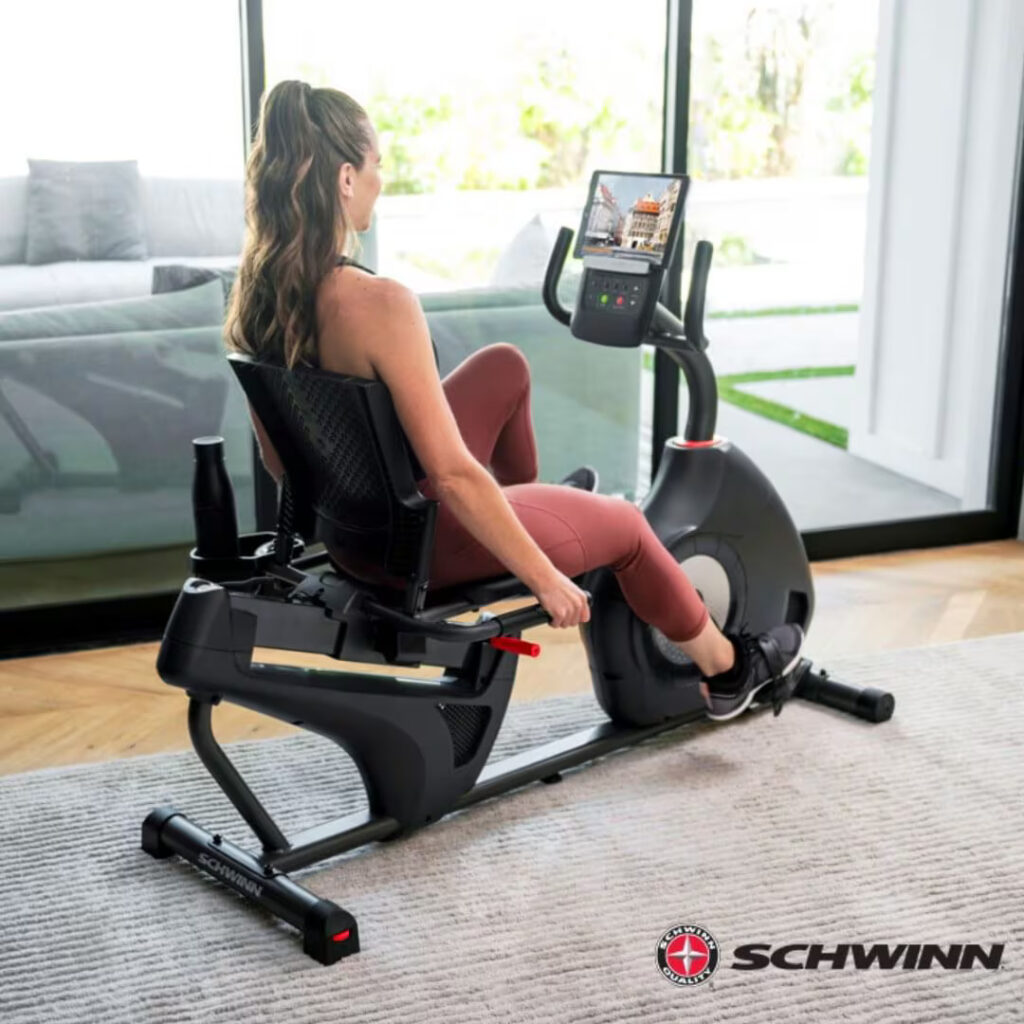
The Schwinn 230 is a lightweight recumbent bike with a magnetic flywheel for quiet, adjustable resistance. It works with many third-party health and fitness apps despite having no display.
2. Upright Bike We Recommend
Sunny Health and Fitness Sf-B2952
Whether you want to get in some cardio at home or ride comfortably, this upright bike checks all the boxes.
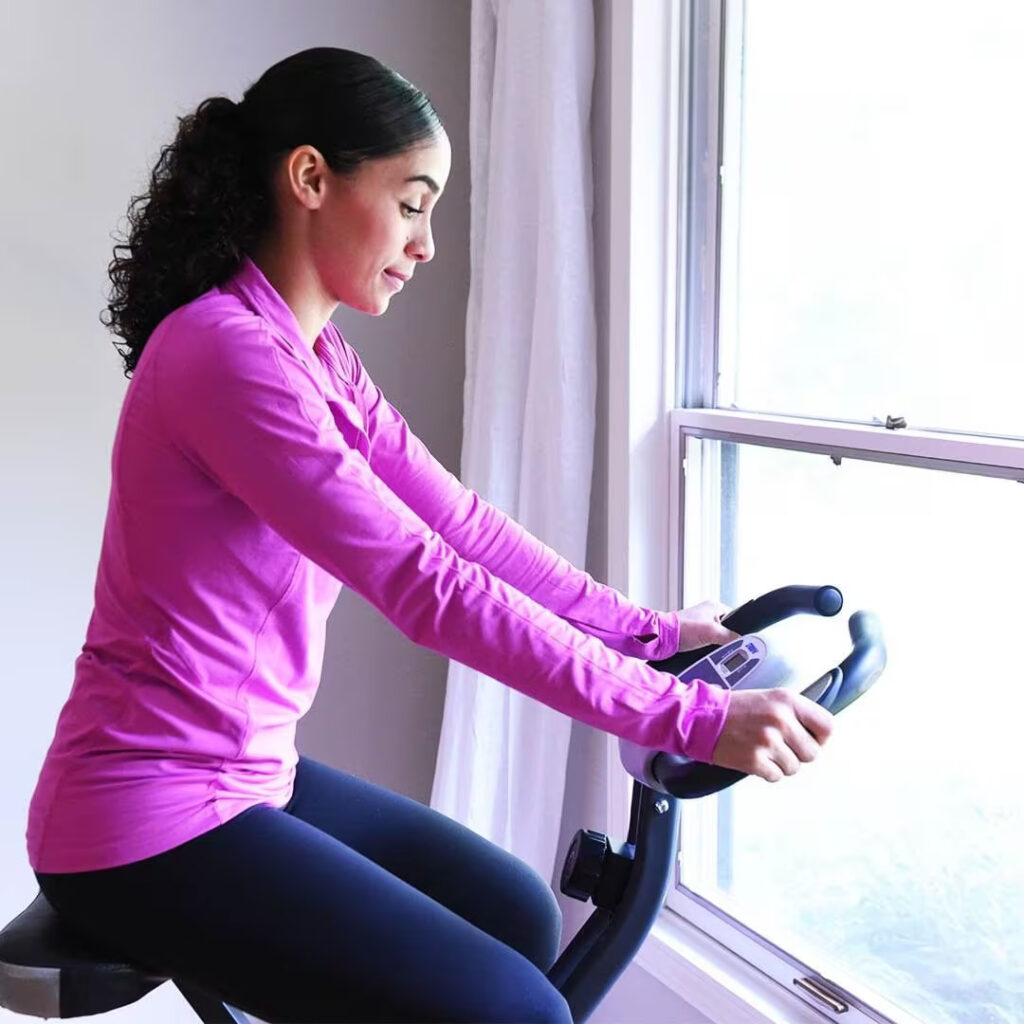
The Sunny Health & Fitness stationary upright bike records time, speed, distance, calories, heart rate, and RPMs and has eight resistance levels and a device holder. The magnetic tension system, floor stabilizers, and transporting wheels provide a quiet journey.
FAQ
What Is the Biggest Difference Between a Stationary Bike and a Recumbent Bike?
The rider’s position on both these bikes best explains the difference. The use of stationary bikes is a risk-free and efficient method of achieving your fitness objectives.
Compared to other cardio equipment forms, stationary bikes are easier on the joints. However, deciding between a recumbent bike and an upright cycle all boils down to personal preference.
Is a Recumbent Bike or Stationary Bike Better for Weight Loss?
Fortunately, you can burn the same number of calories and achieve the same degree of cardiovascular fitness with either bike. It’s up to you to decide how committed you are to using the bike, proper diet and regular training sessions, so choose one you can see yourself riding for a long time and depend on your preferences and goals.
Conclusion
To sum up, an upright exercise bike or recumbent is great cardiovascular and muscle-building equipment.
Ultimately, deciding which option is better for you is up to you. Don’t hesitate to add an upright bike to your home gym if you like working out while sitting in such a position. You should expect quicker muscle growth and weight loss as a result.
However, if riding an upright bike causes discomfort because of your older age and mobility issues, a recumbent bike is the way to go. This bike provides more comfort compared to traditional upright bikes.
Pick the best ones from our choice, and feel free to remark and ask questions in the comment section.
Also read:
- Calories Burned on Stationary Bike
- Exercise Bike Problems
- How Long to Ride a Stationary Bike
- Best Compact Exercise Bikes
- Is the Stationary Bike Good Cardio
- Spinning Bike vs Upright Bike
- Recumbent Bike Benefits
- Calories Burned on Stationary Bike
References:
- 7 Great Benefits of a Stationary Bike Workout // Healthline:
https://www.healthline.com/health/fitness-exercise/stationary-bike-workout - Weight Loss With a Recumbent Bike // Topfitnessmag: https://www.topfitnessmag.com/recumbent-bike-advantages-and-disadvantages/weight-loss-with-a-recumbent-bike
- Tools & Calculators // Acefitness: https://www.acefitness.org/resources/everyone/tools-calculators/physical-activity-calorie-counter/
- 9 Benefits of the Exercise Bike You Should Care About // Healthline: https://www.healthline.com/health/fitness-exercise/exercise-bike-benefits
- Get the Most Out of Stationary Bicycle Workouts // Verywellfit: https://www.verywellfit.com/how-to-use-a-stationary-bike-3120808
- What is the most effective cardio machine in the gym? // Today: https://www.today.com/health/diet-fitness/best-cardio-machine-rcna21809
Why Trust Us?
With over 20 years in Olympic Weightlifting, our team does its best to provide the audience with ultimate support and meet the needs and requirements of advanced athletes and professional lifters, as well as people who strive to open new opportunities and develop their physical capabilities with us.
By trusting the recommendations of our certified experts in coaching, nutrition, dietology, and sports training programming, as well as scientific consultants, and physiotherapists, we provide you with thorough, well-considered, and scientifically proven content. All the information given in the articles concerning workout programming, separate exercises, and athletic performance, in general, is based on verified data. We ensure that you can rely on our professionals’ pieces of advice and recommendations that can be treated as personalized ones which will benefit you and fully meet your needs.
The product testing process is described in more detail here
Author: Ihor Shymechko
Pro Olympic Weightlifter, Coach
Best Results: Snatch – 208 kg,
C&J – 240 kg
Ihor has been a professional weightlifter since 1996, boasting over two decades of competition experience. His notable achievements include clinching the European Championship in 2009 and securing a silver medal in the 105kg division at the Senior World Championships in 2011. Ihor represented his country in the 2008, 2012, and 2016 Summer Olympics. After retiring from competitive weightlifting, he transitioned to coaching, leveraging his vast experience to guide athletes who now compete on both national and international stages.

